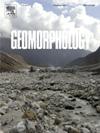Beach-dune dynamics and coastal management along the North-Médoc coastline, southwest France: a decade of morphological change and erosion mitigation
IF 3.1
2区 地球科学
Q2 GEOGRAPHY, PHYSICAL
引用次数: 0
Abstract
The North-Médoc coastline, exposed to energetic waves and meso-macro tides and exhibiting major erosion hot-spots, has experienced notable changes in beach and dune volumes over the last decades due to a combination of natural forcings and human interventions, including coastal defenses and beach nourishment. Annual LiDAR data (2011−2023) combined with interspersed annual GNSS surveys were used to quantify spatial and temporal variations in beach-dune topography along approximately 14.5 km of coastline. Beach-dune changes along the North-Médoc coast over the past decade were influenced by multiple factors at varying scales. (1) Long-term changes, such as chronic erosion or accretion of up to 7 m/yr, are mainly inherited from large-scale shoal welding originating from the estuary mouth (internal forcing). (2) Coastal structures have localized impacts on shoreline dynamics, sometimes altering trajectories. While alongshore structures stabilize the shoreline, they may cause issues at their ends. Cross-shore structures, like groynes, have variable effects; for instance, extending one of the groyne after winter 2013–14 led to rapid accretion, widening beach, and raising elevations updrift. This accreting area is now used as a sediment extraction area to nourish the eroding southern beaches. (3) Interannual shoreline variability, linked to winter wave height fluctuations driven by climate modes of atmospheric variability, overlaps with trends from (1) and (2). However, this external forcing is more pronounced farther from the estuary, indicating a continuum from external forcing on open coasts to internal processes near the estuary.
法国西南部北-姆萨梅多克海岸线的海滩-沙丘动力学和海岸管理:形态变化和减缓侵蚀的十年
在过去的几十年里,由于自然强迫和人为干预(包括海岸防御和海滩营养)的共同作用,暴露在高能波浪和中宏观潮汐下的北-m - 海岸线呈现出主要的侵蚀热点,海滩和沙丘的体积发生了显著变化。利用年度LiDAR数据(2011 - 2023年)和穿插的年度GNSS调查,量化了沿大约14.5 km海岸线的海滩-沙丘地形的时空变化。近十年来,北-海滩沙丘的变化受到多种尺度因素的影响。(1)长期变化,如慢性侵蚀或高达7 m/yr的淤积,主要继承自河口产生的大规模浅滩焊接(内强迫)。(2)海岸结构对岸线动力学有局部影响,有时会改变轨迹。虽然沿岸建筑稳定了海岸线,但它们的末端可能会引起问题。跨岸结构,如沙坝,有不同的影响;例如,2013年至2014年冬季后,其中一个沙坝的延伸导致了快速的增生,拓宽了海滩,并提高了上漂的海拔。这个增积区现在被用作沉积物提取区,以滋养受到侵蚀的南部海滩。(3)与大气变率气候模态驱动的冬季波高波动有关的年际海岸线变率与(1)和(2)的趋势重叠。然而,这种外部强迫在远离河口的地方更为明显,表明从开放海岸的外部强迫到河口附近的内部过程是连续的。
本文章由计算机程序翻译,如有差异,请以英文原文为准。
求助全文
约1分钟内获得全文
求助全文
来源期刊

Geomorphology
地学-地球科学综合
CiteScore
8.00
自引率
10.30%
发文量
309
审稿时长
3.4 months
期刊介绍:
Our journal''s scope includes geomorphic themes of: tectonics and regional structure; glacial processes and landforms; fluvial sequences, Quaternary environmental change and dating; fluvial processes and landforms; mass movement, slopes and periglacial processes; hillslopes and soil erosion; weathering, karst and soils; aeolian processes and landforms, coastal dunes and arid environments; coastal and marine processes, estuaries and lakes; modelling, theoretical and quantitative geomorphology; DEM, GIS and remote sensing methods and applications; hazards, applied and planetary geomorphology; and volcanics.
 求助内容:
求助内容: 应助结果提醒方式:
应助结果提醒方式:


